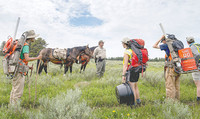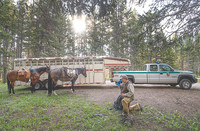Partly Cloudy, 47° F
“She collapsed and was sobbing,” Jones said.
It was a hot day and she had overextended herself. Running out of water, she had become dehydrated. Jones shared his water and stayed with her until he was sure she was healthy enough to continue. …
This item is available in full to subscribers.
The Powell Tribune has expanded its online content. To continue reading, you will need to either log in to your subscriber account, or purchase a subscription.
If you are a current print subscriber, you can set up a free web account by clicking here.
If you already have a web account, but need to reset it, you can do so by clicking here.
If you would like to purchase a subscription click here.
Please log in to continue |
|





As Richard Jones approached a hiker in a backcountry area of Yellowstone National Park, he knew something was wrong.
“She collapsed and was sobbing,” Jones said.
It was a hot day and she had overextended herself. Running out of water, she had become dehydrated. Jones shared his water and stayed with her until he was sure she was healthy enough to continue. After thanking him many times, the hiker was on her way back to her camp with a full water bottle. The next morning Jones checked up on her group to make sure she was safe and on the right trail back to civilization.
Jones, a former Powell resident who now lives in Cody, has met many people on backcountry trails in need of help. Most are just fine but have questions about trail markings, creek crossings, or they simply want to pet his horses. As he meets each hiker, he is quick to offer advice or any help he can. Few pass without at least a short conversation and smiles.
The smiles are one of the few benefits to Jones’ job: He’s a volunteer.
In 2015, the most recent numbers available, the park had more than 2,500 volunteers working more than 100,000 hours at the park. Yellowstone participates in the National Park Service’s Volunteers in Parks (VIP) program. Each year more than 85,000 volunteers donate more than 3 million hours of service in national parks.
People volunteer for every division in the park, from fisheries and geology to the most visible volunteer position, campground host. But it’s not an easy job to get. There are many opportunities, but many more volunteers want to come to Yellowstone than positions exist, according to Jonathan Shafer, public information officer for the park.
“Volunteers enhance the level of service in the park, offer additional resource protection and provide additional safety messaging on top of what regular staff provide,” Shafer said. “It’s a great opportunity for citizens to contribute to a place they own.”
Volunteering is done for a variety of reasons. To some, it’s a great way to get to know the park intimately. Others are seeking experience for future careers.
Each year, Yellowstone National Park welcomes full-time volunteers and interns from the Student Conservation Association (SCA). These volunteers, who may be high school or college students or other adults, assist with vital activities ranging from trail maintenance, bear management or backcountry patrol, to assisting park visitors. In return, the volunteers receive valuable training and experience, have most expenses paid, and are able to live and work in one of America’s premier national parks. In addition to Yellowstone, SCA places volunteers at hundreds of other national and state parks, national forests, wildlife refuges and other natural and historical sites nationwide, according to the Park Service.
Volunteers giving more than 250 hours of their time receive a free pass to the park for a year. That, and visitor gratitude, are all volunteers receive for their efforts. To most, a smile, time in the park and an occasional thank you is more than enough.
Jones’ experience is important to the park, as there are few full-time backcountry rangers, and scores of visitors register for backcountry camping and hiking passes. While there is a class for beginners, including a video on safety concerns, even experienced backcountry travelers can run into problems.
Jones hasn’t always been a volunteer, though it seems as if his career might be bookended by a life of giving the gift of time. Growing up in Indiana, Jones came to Wyoming after graduating with a degree in biology from Hanover College. Inspired by books, movies and television, he had always dreamed of being a park ranger.
His father worked in a factory and his mother in an office as a secretary. Jones couldn’t imagine himself working indoors, so when a family member suggested he volunteer at Shoshone National Forest, he hit the road.
“My parents were always supportive,” Jones said. “They wanted their kids to do what they wanted. Sitting in an office wasn’t something I wanted to do.”
Jones wanted to do something with a purpose and felt the outdoors calling. In 1976, he volunteered to join a trail crew at the national forest and by 1982 he was commissioned as a law enforcement ranger in Yellowstone. He worked as a backcountry ranger, often spending as much as three weeks alone in the forest. He was living his dream.
From the back of a horse, Jones has traveled through much of the backcountry of Yellowstone, giving him a unique view of the park. Despite working alone and facing the dangers of the unforgiving wilderness, he felt at home isolated in the woods.
It wasn’t always easy. He’s been chased by grizzlies, nearly dragged to his death after falling from his horse and has spent much of his time chasing poachers. He speaks fondly of his adventures with bears, adores horses and still has anger for those who would enter the park to illegally take its jewels. Even though he carried a .44 magnum, he rarely drew his sidearm — especially against an animal. When he was chased up a tree by a grizzly bear, he just waited it out.
“I figured he could get up the tree if I could,” the former college linebacker said. “He just sat at the base of the tree, snapping his jaws and pacing.”
And when chasing poachers, his greatest weapons were a spotting scope and his stealth instead of a gun. After a few big cases he helped prosecute, the U.S. Fish and Wildlife Service came calling.
Jones was transferred to Chicago first, then to Miami. He investigated cases involving international smuggling of wildlife. But most of the work was done from the office. After receiving yet another offer to transfer to Washington, D.C., Jones once again heard the backcountry calling him, and instead took a job at Lake Clark in Alaska as a seasonal park ranger.
“Office work didn’t agree with him,” said Charles R. Preston, founding curator of the Draper Natural History Museum at Buffalo Bill Center of the West in Cody.
Jones now works with Preston on a golden eagle research project, mapping eagle habitat by plane since 2009.
“We wouldn’t be able to do that project without Richard. He is the glue that holds that project together,” Preston said at a recent speech Jones gave at the Center of the West.
Jones would probably prefer being back in the park as a full-time ranger, but few of those jobs are available. So Jones — needing his backcountry fix — volunteers instead. It’s important to him that he can share his love for the park with visitors who may be on a once-in-a-lifetime trip to the park.
“It’s a magnificent place. I want to share my experience to help them get the most from their visit,” he said.
Jones also reports back to the office if he sees trouble or signs of poaching. Though he no longer has the authority to arrest anyone or even carry a gun, his two-way radio and his experience in the place he loves and has spent most adult life are always with him.
“It’s like being a musician or an artist — it may not always be profitable, but it’s what I do,” Jones said.
Yellowstone National Park determines future volunteer needs at the end of each season and announces its needs for volunteers in the winter.
For more information on becoming a volunteer for Yellowstone National Park, go to www.nps.gov/yell/getinvolved/volunteer.htm.
To view volunteer opportunities across the National Park System, visit www.nps.gov/volunteer or www.volunteer.gov.